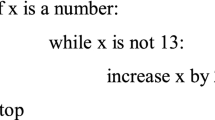Abstract
Chaos-related obstructions to predictability have been used to challenge accounts of theory validation based on the agreement between theoretical predictions and experimental data (Rueger & Sharp, 1996. The British Journal for the Philosophy of Science, 47, 93–112; Koperski, 1998. Philosophy of Science, 40, 194–212). These challenges are incomplete in two respects: (a) they do not show that chaotic regimes are unpredictable in principle (i.e., with unbounded resources) and, as a result, that there is something conceptually wrong with idealized expectations of correct predictions from acceptable theories, and (b) they do not explore whether chaos-induced predictive failures of deterministic models can be remedied by stochastic modeling. In this paper we appeal to an asymptotic analysis of state space trajectories and their numerical approximations to show that chaotic regimes are deterministically unpredictable even with unbounded resources. Additionally, we explain why stochastic models of chaotic systems, while predictively successful in some cases, are in general predictively as limited as deterministic ones. We conclude by suggesting that the way in which scientists deal with such principled obstructions to predictability calls for a more comprehensive approach to theory validation, on which experimental testing is augmented by a multifaceted mathematical analysis of theoretical models, capable of identifying chaos-related predictive failures as due to principled limitations which the world itself imposes on any less-than-omniscient epistemic access to some natural systems.
Similar content being viewed by others
References
Abarbanel H.D.I. (1996). Analysis of observed chaotic data. Springer, New York
Batterman R. (2001). The devil in the details: Asymptotic reasoning in explanation, reduction and emergence. Oxford University Press, New York
Batterman R. (1993). Defining chaos. Philosophy of Science 60, 43–66
Berger A. (2001). Chaos and chance, an introduction to stochastic aspects of dynamics. Walter de Gruyter, New York
Brockwell P.J., Davis R.A. (2002). An introduction to time series and forecasting. Springer-Verlag, New York
Brown J.R. (1976). Ergodic theory and topolgical dynamics. Academic Press, New York
Brown R., Chua L.O. (1998). Clarifying chaos II: Bernoulli chaos, zero lyapunov exponents and strange attractors. International Journal of Bifurcation and Chaos 8, 1–32
da Costa N.C.A., Doria F.A. (1992). On the incompleteness of axiomatized models for the empirical sciences. Philosophica 50, 87–100
Devaney R. (1989). An introduction to chaotic dynamical systems (2nd edn). Addison-Wesley, Redwood City, CA
D’Humieres D., Beasley M.R., Huberman B., Libchaber A. (1982). Chaotic states and routes to chaos in the forced pendulum. Physical Review A 26, 3483–3496
Downey, R. G., & Hirschfeldt, D. (2004). Algorithmic randomness and complexity, e-manuscript, http://www.mcs.vuw.ac.nz/∼downey
Eckmann J.-P. Ruelle D. (1985). Ergodic theory of chaos and strange attractors. Review of Modern Physics, 50, 617–656
Friedlander F.G. (1982). Introduction to the theory of distributions. Cambridge University Press, Cambridge
Gershenfeld N. (1988). An experimentalist’s introduction to the observation of dynamical systems. In: Hao B.L.(Eds). Directions in chaos. World Scientific, New Jersey, pp. 310–382
González-Miranda J.M. (2004). Synchronization and control of chaos. Imperial College Press, London
Holt D.L., Holt R.G.(1993). Regularity in nonlinear dynamical systems. British Journal for the Philosophy of Science 44, 711–727
Hsu C.S. (1987). Cell-to-cell mapping: A method of global analysis for non-linear systems. Springer, New York
Hunt G.M.K. (1987) Determinism, predictability and chaos. Analysis 47, 129–133
Koperski J. (1998). Models, confirmation and chaos. Philosophy of Science 65, 624–648
Krylov N., Bogoliubov N. (1937) La theorie generale de la measure dans son application a l’etude des systemes dynamiques de la mechanique non lineare. Annals of Mathematics 38, 65–113
Lasota A., Mackey M.C. (1994). Chaos, fractals and noise, stochastic aspects of dynamics (2nd ed). Springer-Verlag, New York
Li M., Vitanyi P.M. (1997). An introduction to Kolmogorov complexity and its applications (2nd ed). Springer-Verlag, Berlin
Martelli M., Dang M., Seph T. (1998). Defining chaos. Mathematics Magazine 71, 112–122
May R.M. (1974). Biological populations with non-overlapping generations: stable points, stable cycles, and chaos. Science 186, 645–647
Moore C. (1991). Generalized shifts: Unpredictability and undecidability in dynamical systems. Nonlinearity 4, 199–230
Robinson C. (1999). Dynamical systems, stability, symbolic dynamics and chaos (2nd ed). CRC Press, New York
Rueger A., Sharp W.D. (1996). Simple theories of a messy world: truth and explanatory power in nonlinear dynamics. The British Journal for the Philosophy of Science 47, 93–112
Ruelle D. (1994) Where can one hope to profitably apply the ideas of chaos?. Physics Today 47, 24–30
Schwartz L. (1973). Thèorie des distributions. Hermann, Paris
Sinai Ya. G. (1972). Gibbs measures in ergodic theory. Russian Mathematical Surveys 27, 21–69
Sklar L. (1973). Statistical explanation and ergodic theory. Philosophy of Science 40, 194–212
Smith P. (1998). Explaining chaos. Cambridge University Press, Cambridge
Solovay R.M. (2000). A version of Ω for which ZFC can not predict a single bit. In Calude C.S., Paun G.(Eds). Finite versus infinite contributions to an eternal dilemma. Springer-Verlag, London, pp. 323–334
Steeb W.H., Van Wyk M.A. (1997). Chaos in electronics. Kluwer Academic Publishers, Dordrecht, Holland
Stone M. (1989) Chaos, prediction and Laplacean determinism. American Philosophical Quarterly 26, 123–131
Takens F. (1981). Detecting strange attractors in turbulence. In: Rand D.A., Young L.-S.(Eds). Dyamical systems and turbulence. Warwick 1980, Springer Lecture Notes in Mathematics vol. 898, Springer-Verlag, New York, pp. 366–381
Turing A. (1937). On computable numbers with an application to the Entscheidungsproblem. Proceedings of the London Mathematical Society, 43, 544–546
Winnie J.A. (1992). Computable Chaos. Philosophy of Science 59, 263–275
Yuan G., Yorke J.A. (2000). Collapsing of chaos in one dimensional maps. Physica D, 136, 18–30
Young L.-S. (1986). Stochastic stability of hyperbolic attractors. Ergodic Theory and Dynamical Systems 6, 311–319
Author information
Authors and Affiliations
Corresponding author
Additional information
We give special thanks to two anonymous reviewers for their helpful comments that have substantially contributed to the final version of this paper
Rights and permissions
About this article
Cite this article
Batitsky, V., Domotor, Z. When good theories make bad predictions. Synthese 157, 79–103 (2007). https://doi.org/10.1007/s11229-006-9033-0
Received:
Accepted:
Published:
Issue Date:
DOI: https://doi.org/10.1007/s11229-006-9033-0




